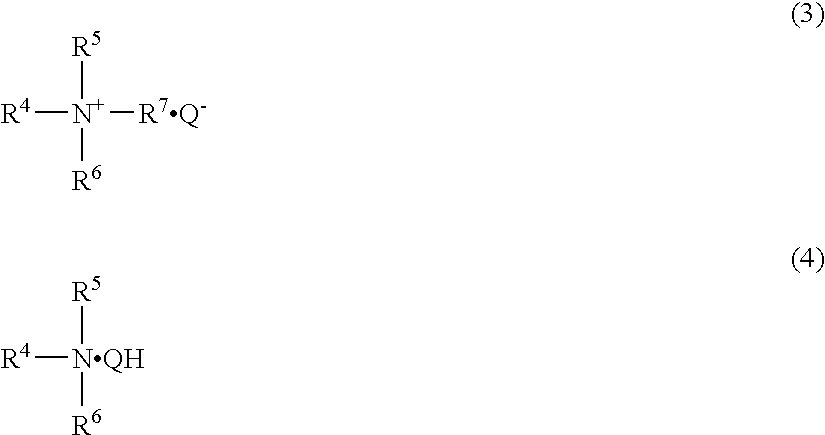Oiling Agent for Fiber Treatment
a technology of oiling agent and fiber, which is applied in the direction of lubricant composition, chemistry apparatus and processes, organic chemistry, etc., can solve the problems of poor rewindability in the subsequent processing step, marked reduction in productivity, and high rate of rewinding in the step of warping, and achieve excellent anti-tackiness properties, stable rewinding, and marked tendency to tack
- Summary
- Abstract
- Description
- Claims
- Application Information
AI Technical Summary
Benefits of technology
Problems solved by technology
Method used
Image
Examples
production example 1
[0199]A powder (71.2 parts) of low-molecular-weight polypropylene with a Mn of 2,500 and a density of 0.89 as obtained by the thermal degradation method was dispersed in 500 ml of tetrahydrofuran (THF), 6.5 parts of 9-borabicyclononane was added, and the mixture was heated at 55° C. for 5 hours with stirring. The temperature was lowered to 45° C., 30 ml of oxygen was passed through the liquid, 22.3 parts of maleic anhydride was added, and the reaction was allowed to proceed for 16 hours. Thereafter, the reaction mixture was poured into 5 liters of 2-propanol, the solid was filtered off to give acid-modified polypropylene [acid value: 335.1, Mn: 3,000, number of carboxyl groups per molecule: 16.0].
example 1
[0201]A mixture of 1 part of magnesium distearate, 2 parts of polyoxyethylene isotridecyl ether-acetic acid sodium salt (adduct with 3 moles of EO), 4 parts of polyoxyethylene lauryl ether-acetic acid (adduct with 2.5 moles of EO), 2 parts of didecyldimethylammonium polyoxyethylene lauryl ether-acetate (adduct with 2.5 moles of EO) and 60 parts of liquid paraffin was stirred at 70 to 80° C. for 1 hour. Then, 31 parts of polydimethylsiloxane was added, and the resulting mixture was cooled to 30° C., whereby the lubricant for treating fibers of Example 1 was prepared.
example 2
[0202]A mixture of 2 parts of magnesium distearate, 3 parts of polyoxyethylene isotridecyl ether-acetic acid sodium salt (adduct with 3 moles of EO), 6 parts of polyoxyethylene lauryl ether-acetic acid (adduct with 2.5 moles of EO), 3 parts of didecyldimethylammonium polyoxyethylene lauryl ether-acetate (adduct with 2.5 moles of EO) and 68 parts of liquid paraffin was stirred at 70 to 80° C. for 1 hour. Then, 18 parts of polydimethylsiloxane was added, and the resulting mixture was cooled to 30° C., whereby the lubricant for treating fibers of Example 2 was prepared.
PUM
| Property | Measurement | Unit |
|---|---|---|
| angle of contact | aaaaa | aaaaa |
| angle of contact | aaaaa | aaaaa |
| angle of contact | aaaaa | aaaaa |
Abstract
Description
Claims
Application Information
 Login to View More
Login to View More - R&D
- Intellectual Property
- Life Sciences
- Materials
- Tech Scout
- Unparalleled Data Quality
- Higher Quality Content
- 60% Fewer Hallucinations
Browse by: Latest US Patents, China's latest patents, Technical Efficacy Thesaurus, Application Domain, Technology Topic, Popular Technical Reports.
© 2025 PatSnap. All rights reserved.Legal|Privacy policy|Modern Slavery Act Transparency Statement|Sitemap|About US| Contact US: help@patsnap.com



